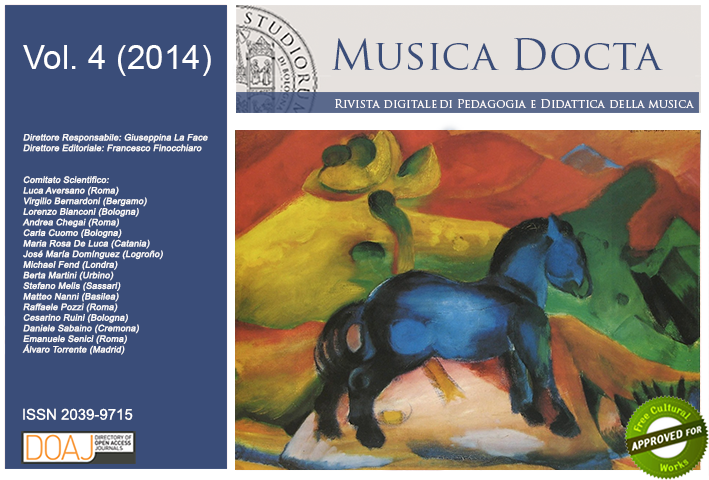Ascoltare (e far ascoltare) il melodramma: qualche istruzione per l’uso
DOI:
https://doi.org/10.6092/issn.2039-9715/4604Parole chiave:
opera, teaching, literature, arts, cinema, cultural studiesAbstract
In the present cultural situation it’s hard for students approaching to the world of lyric opera (on the contrary, modern technological opportunities might make it very easy).
First of all, it is important remembering them that opera is about theatre, a dramatic performance that employs music as its main way of communication: that’s why the librettos have to be considered very seriously. One must explain carefully the stories they tell, trying to fill the linguistic and cultural gaps not easily understandable today.
A way of smoothing the approach could be introducing previously those types of opera that mix spoken and sung performance: musical, opéra-comique, Singspiel, melodrama.
Very important results weaving the cultural and historical fabric of the times when an opera is born, and the sources of its libretto (dramas, novels, historiography): furthermore, stressing spots and links with contemporary external data.
However, it is not less important stressing the opposite direction: that means, how much literature, arts and ultimately movies owe to opera.
Finally, during an opera different chronological times are represented, expressed by different techniques and fixed in different musical structures. They all contribute to assemble the complex general architecture an opera consists of: analyzing and dissecting that machine is surely a good exercise for young students (even for more aged people).
Downloads
Pubblicato
Come citare
Fascicolo
Sezione
Licenza
Copyright (c) 2014 Paolo Fabbri
I diritti d'autore di tutti i testi nella rivista appartengono ai rispettivi autori senza restrizioni.
La rivista è rilasciata sotto una licenza Creative Commons Attribuzione Condividi allo stesso modo 4.0 Internazionale (codice legale completo).
Vedere inoltre la nostra Open Access Policy.
Metadati
Tutti i metadati dei materiali pubblicati sono rilasciati in pubblico dominio e possono essere utilizzati da ognuno per qualsiasi scopo. Questi includono i riferimenti bibliografici.
I metadati – riferimenti bibliografici inclusi – possono essere riutilizzati in qualsiasi formato senza ulteriori autorizzazioni, incluso per scopo di lucro. Chiediamo cortesemente agli utenti di includere un collegamento ai metadati originali.






